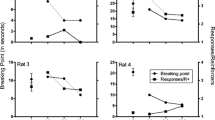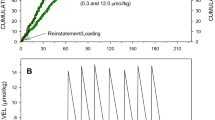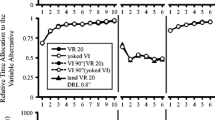Abstract
Squirrel monkeys responded under a multiple schedule in which 30 responses during a specified time limit resulted in either food presentation or termination of visual stimuli associated with impending shock delivery. Schedule components were associated with different colored lights and were separated by 60-s timeout periods in which all lights were extinguished. If the response requirement was not met within the time limit, either the time-out period alone (food components) was presented or a single shock was delivered coincident with onset of time-out. In experiments with d-amphetamine, different control rates of responding were engendered by varying the time limit. When the time limit was 60 s, all monkeys responded at higher overall rates during food presentation components. When the time limit was reduced to 15s, rates of responding in both components increased and became more similar than under the 60-s limit. When control rates in the two components differed under the 60-s time limit, d-amphetamine sulfate (0.01–1.0 mg/kg) increased the normally lower rates under the shock schedule at intermediate doses, but generally only decreased the higher rates under the food schedule. With more comparable control rates under the 15-s time limit, the effects of amphetamine were also more comparable. In most cases low and moderate doses either had little effect or slightly increased responding in both schedule components and higher doses decreased responding. Morphine sulfate (0.03–1.7 mg/kg) and clozapine (0.1 – 3.0 mg/kg) decreased responding comparably under both food and shock schedules with the 15-s time limit.
Similar content being viewed by others
References
Barrett JE (1976) Effects of alcohol, chlordiazepoxide, cocaine and pentobarbital on responding maintained under fixed-interval schedules of food or shock presentation. J Pharmacol Exp Ther 196:605–615
Canon JG (1979) A comparison of clozapine, chlorpromazine, and thioridazine upon DRL performance in the squirrel monkey. Psychopharmacology 64:55–60
Dews PB, Wenger GR (1977) Rate-dependency of the behavioral effects of amphetamine. In: Thompson T, Dews PB (eds) Advances in behavioral pharmacology, vol 1. Academic Press, New York p 167
Katz JL, Barrett JE (1978) Ethanol, pentobarbital, and chlordiazepoxide effects in squirrel monkeys responding under fixed-ratio food presentation and stimulus-shock termination schedules. Psychopharmacology 56:153–155
Kelleher RT, Morse WH (1964) Escape behavior and punished behavior. Fed Proc 23:808–817
Kelleher RT, Morse WH (1968) Determinants of the specificity of the behavioral effects of drugs. Ergebn Physiol Biol Chem Exp Pharmakol 60:1–56
McKearney JW (1973) Methamphetamine effects on responding under a multiple schedule of shock presentation. Pharmacol Biochem Behav 1:547–550
McKearney JW (1974) Effects of d-amphetamine, morphine, and chlorpromazine on responding under fixed-interval schedules of food presentation or electric shock presentation. J Pharmacol Exp Ther 190:141–153
McKearney JW (1975) Effects of morphine, methadone, nalorphine, and naloxone on responding under fixed-interval (FI) schedules in the squirrel monkey. Fed Proc 34:766 (abstract)
McKearney JW (1979) Interrelations among prior experience and current conditions in the determination of behavior and the effects of drugs. In: Thompson T, Dews PB (eds) Advances in behavioral pharmacology, vol 2 Academic Press, New York p 39
McKearney JW, Barrett JE (1975) Punished behavior: Increases in responding after d-amphetamine. Psychopharmacologia 41: 23–26
McKearney JW, Barrett JE (1978) Schedule-controlled behavior and the effects of drugs. In: Blackman DE, Sanger DJ (eds) Contemporary research in behavioral pharmacology, Plenum Press, New York p 1
Morse WH, McKearney JW, Kelleher RT (1977) Control of behavior by noxious stimuli. In: Iversen LL, Iversen SD, Snyder SH (eds) Handbook of psychopharmacology: Principles of behavioral pharmacology, vol 7 Plenum Press, New York p 151
Spealman RD, Katz JL (1980) Some effects of clozapine on punished responding by mice and squirrel monkeys. J Pharmacol Exp Ther 212:435–440
Author information
Authors and Affiliations
Rights and permissions
About this article
Cite this article
McKearney, J.W. Fixed ratio schedules of food presentation and stimulus shock termination: Effects of d-amphetamine, morphine, and clozapine. Psychopharmacology 70, 35–39 (1980). https://doi.org/10.1007/BF00432367
Received:
Accepted:
Issue Date:
DOI: https://doi.org/10.1007/BF00432367




